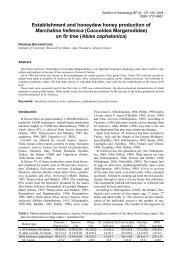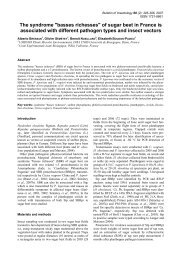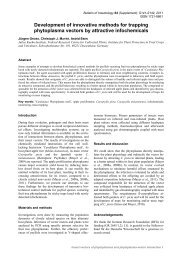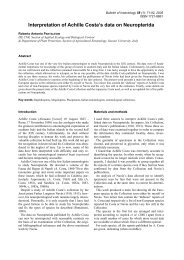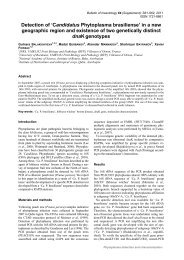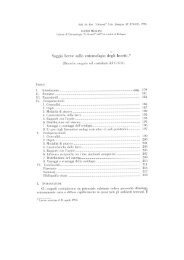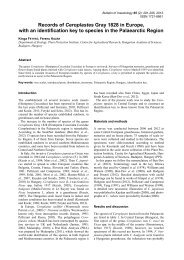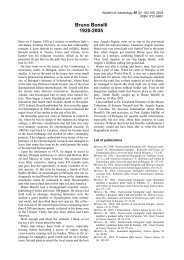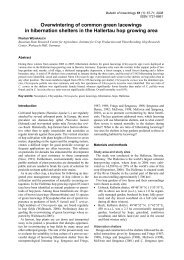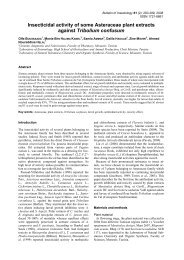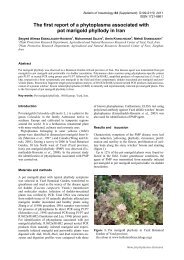Diptera Syrphidae caught by Malaise trap in Bologna province and ...
Diptera Syrphidae caught by Malaise trap in Bologna province and ...
Diptera Syrphidae caught by Malaise trap in Bologna province and ...
Create successful ePaper yourself
Turn your PDF publications into a flip-book with our unique Google optimized e-Paper software.
Bullet<strong>in</strong> of Insectology 55 (1-2): 43-47<br />
<strong>Diptera</strong> <strong>Syrphidae</strong> <strong>caught</strong> <strong>by</strong> <strong>Malaise</strong> <strong>trap</strong> <strong>in</strong> <strong>Bologna</strong><br />
prov<strong>in</strong>ce <strong>and</strong> new record of Neoascia <strong>in</strong>terrupta <strong>in</strong> Italy<br />
Giovanni BURGIO 1 , Daniele SOMMAGGIO 2<br />
1 Dipartimento di Scienze e Tecnologie Agroambientali - Entomologia, Università di <strong>Bologna</strong>, Italy,<br />
2 Velo D’Astico, Vicenza, Italy<br />
Abstract<br />
A faunistic list of <strong>Syrphidae</strong> <strong>caught</strong> <strong>by</strong> h<strong>and</strong> net <strong>and</strong> <strong>by</strong> <strong>Malaise</strong> <strong>trap</strong> <strong>in</strong> a farm <strong>in</strong> <strong>Bologna</strong> prov<strong>in</strong>ce is presented. A total of 31<br />
species were found, 19 of which <strong>caught</strong> <strong>by</strong> <strong>Malaise</strong> <strong>and</strong> 20 <strong>by</strong> h<strong>and</strong> net. Neoascia <strong>in</strong>terrupta (Meigen) is new record for Italian<br />
fauna. Among the species collected we note the occurrence of Lejogaster tarsata (Megerle <strong>in</strong> Meigen), collected <strong>by</strong> <strong>Malaise</strong>, <strong>and</strong><br />
Chalcosyrphus nemorum (F.), collected <strong>by</strong> h<strong>and</strong> net. A comparison between the two techniques is debated.<br />
Key words: <strong>Diptera</strong> <strong>Syrphidae</strong>, Neoascia <strong>in</strong>terrupta, faunistic list, <strong>Malaise</strong> <strong>trap</strong>, h<strong>and</strong> net.<br />
Introduction<br />
<strong>Diptera</strong> <strong>Syrphidae</strong> comprise one of the largest families<br />
of <strong>Diptera</strong> <strong>and</strong> their use as potential bio<strong>in</strong>dicator has<br />
been underl<strong>in</strong>ed (Speight, 1986; Sommaggio, 1999;<br />
Speight <strong>and</strong> Castella, 2001). <strong>Syrphidae</strong> possess features<br />
that would make them potentially good <strong>in</strong>dicators<br />
(Sommaggio, 1999), moreover <strong>Syrphidae</strong> can be helpful<br />
Table 1. Faunistic researches of <strong>Syrphidae</strong> <strong>in</strong> Italy.<br />
Author Year Environment<br />
to predict the <strong>in</strong>tr<strong>in</strong>sic quality <strong>and</strong>/or to study the biodiversity<br />
of agroecosystems. In Italy the knowledge of<br />
this group is reduced; also the number of recent faunistical<br />
list is <strong>in</strong> great need of improvement: table 1 illustrates<br />
the faunistic studies about this family from 1960.<br />
Thus there is the need to improve the knowledge of this<br />
group to develop species lists for the <strong>in</strong>vestigated target<br />
sites (Speight, 2001).<br />
Number of<br />
species<br />
sampled<br />
Setti 1972 Orchard (<strong>Bologna</strong>) 9<br />
Sampl<strong>in</strong>g method<br />
Eggs <strong>and</strong> larvae collection,<br />
h<strong>and</strong> net<br />
Daccordi 1979 Orchard (Verona) 33 H<strong>and</strong> net, yellow <strong>trap</strong><br />
Daccordi et al. 1981 Forest (Monti Less<strong>in</strong>i, Trento) 66 H<strong>and</strong> net, yellow <strong>trap</strong><br />
Chem<strong>in</strong>i et al. 1985 Orchard, marsh, forest (Trento, Verona) 45 H<strong>and</strong> net, yellow <strong>trap</strong><br />
Chem<strong>in</strong>i et al. 1986 Forest (Monti Less<strong>in</strong>i, Trento) 46 H<strong>and</strong> net, yellow <strong>trap</strong><br />
Daccordi et al. 1988 Orchard (Verona) 36 Yellow <strong>trap</strong><br />
Pluch<strong>in</strong>o 1988 Urban park (Verona) 24-27 Yellow <strong>trap</strong><br />
Daccordi <strong>and</strong><br />
Marogna<br />
1989 Marsh (Verona, Mantova) 31 H<strong>and</strong> net, yellow <strong>trap</strong><br />
Biondi et al. 1991 Marsh (Circeo Nat. Park, Lazio) 28 Yellow <strong>trap</strong><br />
Burgio <strong>and</strong><br />
Daccordi<br />
1997 Castiglion dei Pepoli Forest (<strong>Bologna</strong>) 73 H<strong>and</strong> net<br />
Burgio et al. 1997 Farms (<strong>Bologna</strong>) 36 H<strong>and</strong> net<br />
Burgio et al. 2000 Campigna Forest (Forlì) 92 H<strong>and</strong> net<br />
Birtele et al. 2002 Fontana Forest (Mantova) 66 <strong>Malaise</strong> <strong>trap</strong>, h<strong>and</strong> net<br />
Quaranta et al. 2002<br />
Farms (Friuli, Piemonte, Emilia-<br />
Romagna, Toscana, Sardegna, Umbria,<br />
Lazio, Sicilia)<br />
Not<br />
reported<br />
H<strong>and</strong> net<br />
Sommaggio In press Pastello Mounta<strong>in</strong> (Verona) 71 <strong>Malaise</strong> <strong>trap</strong>, h<strong>and</strong> net<br />
Sommaggio In press Summano Mounta<strong>in</strong> (Vicenza) 85 <strong>Malaise</strong> <strong>trap</strong>, h<strong>and</strong> net<br />
Burgio <strong>and</strong><br />
Sommaggio<br />
In press Farm (<strong>Bologna</strong>) 31 <strong>Malaise</strong> <strong>trap</strong>, h<strong>and</strong> net<br />
Delmastro <strong>and</strong><br />
Sommaggio<br />
In press Mounta<strong>in</strong> pasture (Cuneo, Tor<strong>in</strong>o) 90 H<strong>and</strong> net
The aim of our research was to study the species of<br />
<strong>Syrphidae</strong> <strong>in</strong> an organic farm characterized <strong>by</strong> high floristic<br />
diversity due to hedgerows <strong>and</strong> grassy marg<strong>in</strong>, to<br />
complete the regional faunistic lists of these <strong>in</strong>sects.<br />
Both <strong>Malaise</strong> <strong>and</strong> h<strong>and</strong> net has been used <strong>in</strong> order to<br />
better assess the local <strong>Syrphidae</strong> population. A comparison<br />
between the two techniques will be debate <strong>in</strong> this<br />
paper; a stronger discussion about the two different<br />
techniques will be the ma<strong>in</strong> topic of another paper<br />
(Sommaggio <strong>and</strong> Burgio, <strong>in</strong> prep.).<br />
Materials <strong>and</strong> methods<br />
One <strong>Malaise</strong> <strong>trap</strong> was placed <strong>in</strong> the organic farm<br />
«Maieutica» (S. Giovanni <strong>in</strong> Persiceto, <strong>Bologna</strong> prov<strong>in</strong>ce,<br />
Northern Italy) along a hedgerow at field boundary.<br />
The plant species of the hedgerow were: cherry-tree<br />
(Prunus avium L.), hawthorn (Crataegus monogyna<br />
Jacq.), blackthorn (Prunus sp<strong>in</strong>osa L.), maple (Acer<br />
campestre L.), elder (Sambucus nigra L.), dogrose<br />
(Rosa can<strong>in</strong>a L.), Cornus sangu<strong>in</strong>ea L., poplar (Populus<br />
alba L.).<br />
Figure 1. Map of Italy. The dot <strong>in</strong>dicates the <strong>in</strong>vestigated<br />
site.<br />
The sampl<strong>in</strong>g covered the period from the end of<br />
April to the beg<strong>in</strong>n<strong>in</strong>g of September 1996. The <strong>trap</strong> was<br />
baited <strong>by</strong> alcool (80%) <strong>and</strong> periodically the <strong>caught</strong> species<br />
were isolated <strong>and</strong> identified. Sampl<strong>in</strong>gs <strong>by</strong> h<strong>and</strong> net<br />
were also carried out every week from beg<strong>in</strong>n<strong>in</strong>g of<br />
May to mid September, collect<strong>in</strong>g for 30 m<strong>in</strong>utes the<br />
syrphid adults <strong>in</strong> a transept along the hedgerow <strong>and</strong> a<br />
grassy boundary.<br />
For the identification of the species the follow<strong>in</strong>g keys<br />
has been used: Goeldl<strong>in</strong> de Tiefenau (1976), Stubbs <strong>and</strong><br />
Falk (1983), Barkemeyer <strong>and</strong> Claussen (1986),<br />
Bradescu (1990), Verl<strong>in</strong>den (1994), Verd<strong>in</strong>den (1999).<br />
44<br />
S. Giovanni <strong>in</strong> Persiceto<br />
(<strong>Bologna</strong>)<br />
Results <strong>and</strong> discussion<br />
The faunistic list of <strong>Syrphidae</strong> collected is presented<br />
<strong>in</strong> table 2; a total of 31 species were collected, <strong>in</strong>clud<strong>in</strong>g<br />
19 species <strong>caught</strong> <strong>by</strong> <strong>Malaise</strong> <strong>trap</strong> <strong>and</strong> 20 species <strong>caught</strong><br />
<strong>by</strong> h<strong>and</strong> net (table 3). The high percentage of predacious<br />
species is typical of several habitats <strong>and</strong> <strong>in</strong> particular of<br />
agricultural l<strong>and</strong>scapes (Bankowska, 1980). The very<br />
low percentage of phytophagous species (only Eumerus<br />
sogdianus Stackelberg, 1952, sampled <strong>by</strong> <strong>Malaise</strong>, was<br />
collected) can <strong>in</strong>dicate a relative reduction <strong>in</strong> weed diversity,<br />
probably due to the reduced size of the sampl<strong>in</strong>g<br />
site; but this <strong>in</strong>ference is only a hypothesis because the<br />
sampl<strong>in</strong>g was carried out only one year.<br />
Neoascia <strong>in</strong>terrupta (Meigen), collected <strong>by</strong> <strong>Malaise</strong><br />
<strong>trap</strong>, is new record for Italian fauna. The Italian fauna of<br />
Neoascia Williston now comprises six species: Neoascia<br />
annexa (O.F. Muller, 1776), N. podagrica (Fabricius,<br />
1775.) <strong>and</strong> N. tenur (Harris, 1780) belong<strong>in</strong>g to the<br />
subgenus Neoascia; N. <strong>in</strong>terrupta (Meigen, 1822), N.<br />
meticulosa (Scopoli, 1763) <strong>and</strong> N. obliqua Coe, 1940,<br />
belong<strong>in</strong>g to Neoasciella subgenus. Accord<strong>in</strong>gly to<br />
Speight (2001) three other Neaoscia species occur <strong>in</strong><br />
Europe. Neoascia subchalybea Curran, 1925, is probably<br />
present only <strong>in</strong> the Sc<strong>and</strong><strong>in</strong>avia, Siberia <strong>and</strong> Canada<br />
<strong>and</strong> likely does not occur <strong>in</strong> Italy; the distribution of the<br />
other two species, N. geniculata (Meigen, 1822) <strong>and</strong> N.<br />
unifasciata (Strobl, 1898) is ma<strong>in</strong>ly <strong>in</strong> Central <strong>and</strong><br />
North Europe, as N. <strong>in</strong>terrupta. So their presence <strong>in</strong> Italy<br />
is possible, at least <strong>in</strong> the North.<br />
Notes on the biology of N. <strong>in</strong>terrupta are reported <strong>by</strong><br />
Speight (2001); this species becomes <strong>in</strong>creas<strong>in</strong>gly<br />
coastal towards the northern edge of its range <strong>in</strong> western<br />
Europe, where it occurs primarily <strong>in</strong> association with<br />
coastal lagoons conta<strong>in</strong><strong>in</strong>g beds of reeds of Typha. Further<br />
South <strong>and</strong> <strong>in</strong> Central Europe the species occurs<br />
round the edge of permanent st<strong>and</strong><strong>in</strong>g-water bodies<br />
from small ponds up to the scale of large lakes. The larval<br />
foods habits of N. <strong>in</strong>terrupta is not described; larvae<br />
of Neoascia are found <strong>in</strong> wet manure <strong>in</strong> farmyards <strong>and</strong><br />
from decay<strong>in</strong>g vegetation round the marg<strong>in</strong>s of ponds<br />
(Rotheray, 1993). The present record is consistent with<br />
the known biology of the species.<br />
The only species with phytophagous larvae found <strong>in</strong><br />
this study is E. sogdianus. Eumerus is a genus with<br />
great taxonomic problems <strong>and</strong> is badly <strong>in</strong> need of revision.<br />
E. sogdianus has been actually recorded only for<br />
Sard<strong>in</strong>ia (Belcari et al., 1995; Daccordi <strong>and</strong> Sommaggio,<br />
2002). This species is probably less rare than supposed;<br />
<strong>in</strong> fact it is easily confused with E. strigatus<br />
(Fallen, 1817), a supposed wide distributed species.<br />
Actually the females of the two species can no sufficiently<br />
be separated, while the males can easily be separated<br />
on the base of the 4 th sternite (figure 2). Accord<strong>in</strong>gly<br />
to Speight (2001), E. sogdianus is a species found<br />
<strong>in</strong> open ground; it is present <strong>in</strong> unimproved mounta<strong>in</strong><br />
pasture, <strong>in</strong> farml<strong>and</strong>, especially on s<strong>and</strong>y soils, <strong>in</strong><br />
coastal dune system <strong>and</strong> alluvional floodpla<strong>in</strong>. E. sogdianus<br />
has been collected also along hedgerows <strong>in</strong> the agricultural<br />
l<strong>and</strong>scape near Breganze (VI); it is possible<br />
that this species is well distributed <strong>in</strong> all the Po river<br />
Valley.
Table 2. List of species <strong>caught</strong> <strong>by</strong> <strong>Malaise</strong> <strong>and</strong> h<strong>and</strong> net <strong>in</strong> organic farm «Maieutica» (S.Giovanni <strong>in</strong> Persiceto, Bo).<br />
The numbers <strong>in</strong>dicate the total of sampled specimens. (*): new record <strong>in</strong> Italy. M = <strong>Malaise</strong> <strong>trap</strong>; Hn = h<strong>and</strong> net;<br />
Cat = general trophic category (P =predator; SA= acquatic saprophagous; ST= terrestrial saprophagous; F = phytophagous);<br />
(1): from Rotheray (1993) <strong>and</strong> Speight (2001).<br />
Species M Hn Cat Larval food habits (1)<br />
Epistrophe nitidicollis (Meigen, 1822) 1 0 P<br />
Aphids on trees, but also occurr<strong>in</strong>g on shrubs <strong>and</strong> tall<br />
herbs<br />
Episyrphus balteatus (De Geer, 1776) 10 118 P Wide range of ground layer <strong>and</strong> arboreal aphids<br />
Eupeodes corollae (Fabricius, 1794) 9 1 P Wide range of ground layer aphids<br />
Eupeodes latifasciatus (Macquart, 1829) 10 0 P Predator on root – aphids<br />
Maliscaeva auricollis (Meigen, 1822) 0 4 P Predator n wide range of aphids<br />
Scaeva selenitica (Meigen, 1822) 0 1 P Aphids feed<strong>in</strong>g on shrubs <strong>and</strong> trees<br />
Sphaerophoria scripta (L<strong>in</strong>naeus, 1758) 69 13 P Ground layer aphids<br />
Sphaerophoria rueppelli (Wiedmann,<br />
1830)<br />
1 0 P Ground layer aphids<br />
Syrphus ribesii (L<strong>in</strong>naeus, 1758) 0 2 P Ground layer <strong>and</strong> arboreal aphids<br />
Syrphus vitripennis Meigen, 1822 0 9 P Ground layer <strong>and</strong> arboreal aphids<br />
Xanthogramma festivum (L<strong>in</strong>naues, 1758) 0 1 P<br />
The larvae live <strong>in</strong> Lasius - ant nests, where probably<br />
Chrysotoxum cautum (Harris, 1776) 3 1 P<br />
feed on root aphids associated with the ant colonies<br />
The larvae of this species is completely unknown; <strong>in</strong><br />
the genus Chrysotoxum the larvae seem to be associated<br />
with ants, probably feed<strong>in</strong>g on ant-attended root<br />
aphids.<br />
Melanostoma mell<strong>in</strong>um (L<strong>in</strong>naues, 1758) 70 18 P<br />
Aphids feed<strong>in</strong>g on a wide range of aphids on low<br />
grow<strong>in</strong>g plants<br />
Melanostoma scalare (Fabricius, 1794) 0 2 P Predators on aphids<br />
Paragus haemorrhous Meigen, 1822 4 1 P Ground layer <strong>and</strong> arboreal aphids.<br />
Paragus majoranae Rondani, 1857 6 0 P Ground layer <strong>and</strong> arboreal aphids, also on many crops<br />
Paragus sp. (females) 22 0 P<br />
Pipizella maculipennis (Meigen, 1822) 5 0 P<br />
Larva unknown, probably aphid feed<strong>in</strong>g as the other<br />
known larvae of Pipizella genus<br />
Pipizella viduata (L<strong>in</strong>naues, 1758) 14 0 P Root-feed<strong>in</strong>g aphids on umbelliferous plants<br />
Pipizella sp. (females) 49 0<br />
Lejogaster tarsata (Megerle <strong>in</strong> Meigen,<br />
1822) (= splendida Meigen)<br />
1 0 SA<br />
Neoascia <strong>in</strong>terrupta (Meigen, 1822) (*) 1 0 SA<br />
Acquatic larvae, found <strong>in</strong> accumulations of decay<strong>in</strong>g<br />
vegetation <strong>and</strong> mud <strong>in</strong> pools, ponds <strong>and</strong> slow-mov<strong>in</strong>g<br />
streams<br />
Not described. Larvae of Neoascia are found <strong>in</strong> wet<br />
manure <strong>in</strong> farmyards <strong>and</strong> from decay<strong>in</strong>g vegetation<br />
round the marg<strong>in</strong>s of ponds<br />
Eumerus sogdianus Stackelberg, 1952 18 0 F Larvae liv<strong>in</strong>g <strong>in</strong> plant bulbs<br />
Eristal<strong>in</strong>us aeneus (Scopoli, 1763) 0 4 SA<br />
Larvae occurs along shorel<strong>in</strong>es <strong>in</strong> rock pools conta<strong>in</strong><strong>in</strong>g<br />
large amounts of decay<strong>in</strong>g seaweed<br />
Eristalis arbustorum (L<strong>in</strong>naeus, 1758) 3 10 SA Larvae associated with wet decay<strong>in</strong>g organic material<br />
Eristalis tenax (L<strong>in</strong>naues, 1758) 0 4 SA Larvae associated with wet decay<strong>in</strong>g organic material<br />
Helophilus pendulus (L<strong>in</strong>naues, 1758) 9 12 SA Larvae associated with wet decay<strong>in</strong>g organic material<br />
Helophilus trivittatus (Fabricius, 1805) 0 1 SA Larvae associated with wet decay<strong>in</strong>g organic material<br />
Parhelophilus frutetorum (Fabricius, 1794) 1 0 SA<br />
Larvae associated with accumulations of decay<strong>in</strong>g<br />
vegetation.<br />
Myathropa florea (L<strong>in</strong>naues, 1758) 0 3 SA<br />
Larvae associated with decay<strong>in</strong>g vegetation <strong>in</strong> rotholes<br />
<strong>and</strong> <strong>in</strong> decay<strong>in</strong>g heartwood of a variety of trees<br />
Syritta pipiens (L<strong>in</strong>naues, 1758) 0 1 ST<br />
Larvae found <strong>in</strong> various k<strong>in</strong>d of wet, decay<strong>in</strong>g matter<br />
<strong>in</strong>clud<strong>in</strong>g compost, manure <strong>and</strong> silage<br />
Chalcosyrphus nemorum (Fabricius, 1805) 0 1 ST<br />
Larvae found <strong>in</strong> sap runs <strong>and</strong> under bark <strong>in</strong> accumulations<br />
of decay<strong>in</strong>g sap<br />
Xylota segnis (L<strong>in</strong>naeus, 1758) 1 0 ST Larvae found <strong>in</strong> various k<strong>in</strong>d of wet, decay<strong>in</strong>g matter<br />
45
Table 3. Summary of the species <strong>caught</strong> <strong>by</strong> <strong>Malaise</strong> <strong>trap</strong><br />
(M) <strong>and</strong> h<strong>and</strong> net (Hn) for the different larval food<br />
habits.<br />
M Hn Total %<br />
Total specimens 307 207 514 -<br />
Total species 19 20 31 -<br />
Total predacious species 12 11 18 58.1<br />
Total pytophagous species 1 0 1 3.2<br />
Total aquatic saprophagous<br />
species<br />
5 6 9 29.3<br />
Total terrestrial saprophagous<br />
species<br />
1 2 3 9.7<br />
Sorenson 0.35<br />
A group of species [species belong<strong>in</strong>g to Pipizella genus,<br />
Lejogaster tarsata (Megerle <strong>in</strong> Meigen), Epistrophe<br />
nitidicollis (Meigen), Sphaerophoria rueppelli<br />
(Wiedmann), Paragus majoranae Rondani, Neoascia<br />
<strong>in</strong>terrupta (Meigen), Eumerus sogdianus Stackelberg,<br />
Parhelophilus frutetorum (Fabricius), Xylota segnis<br />
(L<strong>in</strong>naeus)] were sampled only <strong>by</strong> <strong>Malaise</strong>. On the other<br />
side Scaeva selenitica (Meigen), Syrphus ribesii (L<strong>in</strong>naeus),<br />
Syrphus vitripennis Meigen, Xanthogramma<br />
festivum (L<strong>in</strong>naeus), Melanostoma scalare (Fabricius),<br />
Eristalis tenax (L<strong>in</strong>naeus), Myathropa florea (L<strong>in</strong>naues),<br />
Helophilus trivittatus (Fabricius), Eristal<strong>in</strong>us<br />
aeneus (Scopoli), Syritta pipiens (L<strong>in</strong>naeus), Chalcosyrphus<br />
nemorum (Fabricius) were sampled <strong>by</strong> h<strong>and</strong><br />
net. In general <strong>Malaise</strong> <strong>trap</strong> seems to be less effective to<br />
collect adults of saprophagous species, <strong>and</strong> this evidence<br />
will be analysed <strong>in</strong> another study (Sommaggio<br />
<strong>and</strong> Burgio, <strong>in</strong> prep.).<br />
In conclusion our prelim<strong>in</strong>ary results seem to demonstrate<br />
that the two different methods are complementary<br />
to sample <strong>and</strong> collect adult hoverflies. <strong>Malaise</strong> <strong>trap</strong> is a<br />
very effective techniques to sample hoverflies <strong>and</strong> it is<br />
considered a st<strong>and</strong>ard method for faunistic studies of<br />
this group (Schmid et al., 2001). Anyway this method is<br />
time consum<strong>in</strong>g <strong>and</strong> seems to be less effective to sample<br />
some group (Sommaggio <strong>and</strong> Burgio, <strong>in</strong> prep.). <strong>Malaise</strong><br />
<strong>trap</strong> could be baited with phenylacetaldehyde (PAA), a<br />
compound demonstrated to be attractive to <strong>in</strong>sect species<br />
<strong>in</strong>clud<strong>in</strong>g Lepidoptera (Cantelo <strong>and</strong> Jacobson,<br />
1979; Burgio <strong>and</strong> Ma<strong>in</strong>i, 1994) <strong>and</strong> <strong>Syrphidae</strong> (Burgio<br />
<strong>and</strong> Ma<strong>in</strong>i, 1994), to enhance the detection of hoverflies<br />
adults. H<strong>and</strong> net is a very practical sampl<strong>in</strong>g technique<br />
but it is not considered a quantitative method <strong>and</strong> is affected<br />
<strong>by</strong> the ability of the collector <strong>and</strong> the meteorological<br />
conditions.<br />
A faunistic list of <strong>Syrphidae</strong> sampled <strong>in</strong> a organic<br />
farm of Northern Italy <strong>by</strong> <strong>Malaise</strong> <strong>trap</strong> <strong>and</strong> h<strong>and</strong> net is<br />
presented. A total of 31 species were collected, <strong>in</strong>clud<strong>in</strong>g<br />
19 species <strong>caught</strong> <strong>by</strong> <strong>Malaise</strong> <strong>trap</strong> <strong>and</strong> 20 species<br />
caugth <strong>by</strong> h<strong>and</strong> net. N. <strong>in</strong>terrupta, collected <strong>by</strong> <strong>Malaise</strong><br />
<strong>trap</strong>, is new record for Italian fauna. Among the species<br />
collected we note the occurrence of L. tarsata, collected<br />
<strong>by</strong> <strong>Malaise</strong>, <strong>and</strong> C. nemorum, collected <strong>by</strong> h<strong>and</strong> net. The<br />
relative efficiency of the two sampl<strong>in</strong>g methods is discussed.<br />
46<br />
Figure 2. Male IV sternite (Scale = 0.5 mm):<br />
a) Eumerus strigatus, b) Eumerus sogdianus.<br />
Acknowledgments<br />
a<br />
b<br />
We are grateful to Roberto Ferrari, Luca Boriani,<br />
Marco Pozzati for their technical support <strong>in</strong> field.<br />
References<br />
BANKOWSKA R., 1980.- Fly communities of the family<br />
<strong>Syrphidae</strong> <strong>in</strong> natural <strong>and</strong> anthropogenic habitats of Pol<strong>and</strong>.-<br />
Memorab. Zool., 33: 3-93<br />
BARKEMEYER W., CLAUSSEN C., 1986.- Zur Identitat von Neoascia<br />
unifasciata (Strobl 1898): mit e<strong>in</strong>em Schlussel fur die<br />
<strong>in</strong> der Bundesrepublik Deutschl<strong>and</strong> nachgewiesenen Arten<br />
der Gattung Neoascia Williston 1886 (<strong>Diptera</strong>: <strong>Syrphidae</strong>).-<br />
Bonn.zool.Beitr., 37: 229-239.<br />
BELCARI A., DACCORDI M., KOZANEK M., MUNARI L., RASPI<br />
A., RIVOSECCHI L., 1995.- <strong>Diptera</strong> Platypezoidea, Syrphoidea.<br />
In: MINELLI A., RUFFO S., LA POSTA S. (eds.): Checklist<br />
delle Specie della Fauna Italiana. Vol. 70, 25pp., Calder<strong>in</strong>i,<br />
<strong>Bologna</strong>.<br />
BIONDI M., DACCORDI M., MASON F., 1991.- Contributo alla<br />
conoscenza dei Ditteri Sirfidi delle aree umide del parco<br />
nazionale del Circeo (Lazio).- Boll. Ass. Romana Entomol.,<br />
45: 9-25.<br />
BIRTELE D., SOMMAGGIO D., SPEIGHT M. C. D., TISATO M.,<br />
2001.- Syrphida. In: MASON F, CERRETTI P., TAGLIAPIETRA<br />
A., SPEIGHT M. C. D, ZAPPAROLI M. (eds): Invertebrati di<br />
una foresta della Pianura Padana Bosco della Fontana.
Centro Nazionale per lo Studio e la Conservazione della<br />
Biodiversità Forestale.- Bosco della Fontana: 115-118.<br />
BRADESCU, V., 1991.- Les Syrphides de Roumanie (<strong>Diptera</strong>,<br />
<strong>Syrphidae</strong>), Clés de déterm<strong>in</strong>ation et répartition.-<br />
Trav.Mus.Hist. nat. Grigore Antipa, 31: 7-83.<br />
BURGIO G., MAINI S., 1994.- Phenylacetaldehyde <strong>trap</strong>p<strong>in</strong>g of<br />
Ostr<strong>in</strong>ia nubilalis (Hb.), Autographa gamma (L.) <strong>and</strong> hoverflies:<br />
<strong>trap</strong> design efficacy.- Boll. Ist. Ent. ”G. Gr<strong>and</strong>i”,<br />
Univ. <strong>Bologna</strong>, 49: 1-14.<br />
BURGIO G., DACCORDI M., 1997.- Ditteri Sirfidi dell’abet<strong>in</strong>a di<br />
Castiglione dei Pepoli (<strong>Bologna</strong>).- Boll. Mus. Reg. Sci.nat.<br />
Tor<strong>in</strong>o, 15 (1): 63-73.<br />
BURGIO G., FERRARI R., BORIANI L., 1997.- Il ruolo delle siepi<br />
nell’ecologia del campo coltivato: analisi di comunità dei<br />
Ditteri Sirfidi <strong>in</strong> aziende della prov<strong>in</strong>cia di <strong>Bologna</strong>.- Boll.<br />
Ist. Ent. ”G. Gr<strong>and</strong>i” Univ. <strong>Bologna</strong>, 51: 69-77.<br />
BURGIO G., SPEIGHT S. C. D., CAMPADELLI G., CRUDELE G.,<br />
2000.- Indag<strong>in</strong>e faunistica sui Ditteri Sirfidi della riserva<br />
naturale biogenetica di Campigna.- Boll. Ist. Ent. ”G.<br />
Gr<strong>and</strong>i” Univ. <strong>Bologna</strong>, 54: 175-182.<br />
CANTELO W. W., JACOBSON M., 1979.- Phenylacetaldehyde<br />
attracts moth to bladder flower <strong>and</strong> to blacklight <strong>trap</strong>s.- Environ.<br />
Entomol., 8: 444-447.<br />
CHEMINI C., DACCORDI M., MASON F., 1985.- La componente<br />
afidifaga <strong>in</strong> alcuni popolamenti di Ditteri Sirfidi nelle prov<strong>in</strong>ce<br />
di Trento e Verona.- Atti XIV Congr. Naz. Ital. Ent.,<br />
Palermo: 73-79.<br />
CHEMINI C., DACCORDI M., MASON F., 1986.- Ditteri Sirfidi di<br />
un bosco a Larice (Larix decidua Mill.) dei Monti Less<strong>in</strong>i<br />
(prov<strong>in</strong>cia di Trento).- Studi Trent<strong>in</strong>i di Scienze naturali, 62:<br />
99-102.<br />
DACCORDI M., 1979.- Ditteri Sirfidi <strong>in</strong> un frutteto a lotta <strong>in</strong>tegrata<br />
nella prov<strong>in</strong>cia di Verona.- Quaderni dell’Azienda<br />
agraria Sperimentale di Villafranca: 3-35.<br />
DACCORDI M., MASON F., GAZZANELLI G., 1981.- Ditteri Sirfidi<br />
<strong>in</strong> una ristretta area forestale dei Monti Less<strong>in</strong>i (prov<strong>in</strong>cia<br />
di Trento).- Studi Trent<strong>in</strong>i di Scienze naturali, 57: 247-<br />
258.<br />
DACCORDI M., MASON F., PLUCHINO P., 1988.- Ditteri Sirfidi<br />
raccolti <strong>in</strong> due vigneti della prov<strong>in</strong>cia di Verona: applicazione<br />
di alcuni algoritmi per l’analisi di comunità (<strong>Diptera</strong>:<br />
<strong>Syrphidae</strong>).- Atti memorie Acc. Agric. Sci. Lett. Verona, 27:<br />
33-43.<br />
DACCORDI M., MAROGNA A., 1989.- Studi sulla palude del<br />
Busatello (Veneto-Lombardia). 25. I Ditteri Sirfidi.- Mem.<br />
Mus. Civ.St. nat. Verona (II ser.) sez. biologica, 7: 223-230.<br />
DACCORDI M., SOMMAGGIO D., 2002.- Fascicolo 070 - <strong>Syrphidae</strong>.-<br />
Bollett<strong>in</strong>o Società Entomologica Italiana, 134: 192-<br />
198.<br />
DELMASTRO G., SOMMAGGIO D., <strong>in</strong> press.- Contributo alla<br />
conoscenza dei Sirfidi (<strong>Diptera</strong>, <strong>Syrphidae</strong>) del Piemonte.-<br />
Boll. Mus. Reg. Sci. Nat. Tor<strong>in</strong>o.<br />
GOELDLIN DE TIEFENAU P., 1976.- Revision du genre Paragus<br />
(Dipt. <strong>Syrphidae</strong>) de la region palearctique occidentale.-<br />
Mitteilungen der Schweizerischen Entomologischen Gesellschaft,<br />
49: 79-108<br />
PLUCHINO P., 1988.- Ditteri Sirfidi raccolti con <strong>trap</strong>pole cromotropiche<br />
nella città di Verona.- Atti XV Congr. Naz. Ital.,<br />
Entomol., L’Aquila: 763-769.<br />
QUARANTA M., AND COLL., 2002.- Il censimento dei pronubi<br />
selvatici <strong>in</strong> Italia, con particolare riferimento agli Imenotteri<br />
Apoidei (nota prelim<strong>in</strong>are).Il ruolo della ricerca <strong>in</strong> apicoltura.<br />
Progetto F<strong>in</strong>alizzato AMA. M<strong>in</strong>istero delle politiche<br />
agricole e forestali. <strong>Bologna</strong>, marzo 2002: 333-344.<br />
ROTHERAY G. E., 1993.- Colour Guide to Hoverfly Larvae<br />
(<strong>Diptera</strong>, <strong>Syrphidae</strong>).- Dipterist Digest, 9: 1-155<br />
SCHMID U., GILBERT F., ROTHERAY G., STAHLS-MAKELA G.,<br />
2001.- First International Workshop on the <strong>Syrphidae</strong>. Stuttgart,<br />
Germany, 6-8 VII 2001: 57 pp.<br />
SETTI M., 1972.- Ricerche sulla attività di alcune specie di Sirfidi<br />
(<strong>Diptera</strong>) predatori di Afidi del melo.- Boll. Ist. Ent.<br />
Univ. <strong>Bologna</strong>, 30: 103-132.<br />
SOMMAGGIO D., 1999.- <strong>Syrphidae</strong>: can they be used as bio<strong>in</strong>dicators?-<br />
Agriculture, Ecosystems & Environment, 74: 343-<br />
356<br />
SOMMAGGIO D., <strong>in</strong> press.- Indag<strong>in</strong>e sulla fauna di <strong>Diptera</strong><br />
<strong>Syrphidae</strong> del Monte Pastello.- Bollett<strong>in</strong>o Museo Civico di<br />
Storia Naturale di Verona.<br />
SOMMAGGIO D., <strong>in</strong> press.- Contributo alla conoscenza dei<br />
Ditteri Sirfidi del Monte Pastello.- Bollett<strong>in</strong>o Museo Civico<br />
di Storia Naturale di Verona.<br />
SPEIGHT M. C. D., 1986.- Criteria for the selection of <strong>in</strong>sects<br />
to be used as bio<strong>in</strong>dicators <strong>in</strong> nature conservation research.<br />
In: Velthuis, H.H.W. (Ed.).- Proc. 3 rd European Congress of<br />
Entomology, Amsterdam: 485-488.<br />
SPEIGHT M. C. D., 2001.- Species accounts of European<br />
<strong>Syrphidae</strong> (<strong>Diptera</strong>): Special commemorative issue, First<br />
International Workshop on the <strong>Syrphidae</strong>, Stuttgart 2001. In:<br />
SPEIGHT M. C. D., CASTELLA E., OBRDLIK P., BALL S. (eds.):<br />
Syrph the Net, the database of European <strong>Syrphidae</strong>, vol.26,<br />
257 pp., Syrph the Net publications, Dubl<strong>in</strong>.<br />
SPEIGHT M. C. D., CASTELLA E., 2001.- An approach to <strong>in</strong>terpretation<br />
of lists of <strong>in</strong>sects us<strong>in</strong>g digitised biological <strong>in</strong>formation<br />
about the species.- J. Insect Cons., 5: 131-139.<br />
STUBBS A. E., FALK S. J., 1993.- British Hoverflies. An illustrated<br />
identification guide.- British Ent. Nat. Hist. Soc. London:<br />
253 pp, 12 tavv.<br />
VERLINDEN L., 1994.- Faune de Belgique. Syrphides. (<strong>Syrphidae</strong>).-<br />
Institut Royal des Sciences Naturalles de Belgique:<br />
289 pp.<br />
VERLINDEN L., 1999.- A new Pipizella (<strong>Diptera</strong>, <strong>Syrphidae</strong>)<br />
from the French <strong>and</strong> Italian Alps, with a key to the Pipizella<br />
species of Central <strong>and</strong> Western Europe.- Volucella, 4 (1/2): 11-<br />
28.<br />
Authors' addresses: Giovanni BURGIO (correspond<strong>in</strong>g<br />
author, e-mail: gburgio@entom.agrsci.unibo.it), DiSTA -<br />
Entomologia, Università di <strong>Bologna</strong>, via Fan<strong>in</strong> 42, 40127<br />
<strong>Bologna</strong>, Italy; Daniele SOMMAGGIO, via Riello 2, 36010 Velo<br />
D’Astico (VI), Italy, e-mail: dsommaggio@tiscal<strong>in</strong>et.it.<br />
Received October 11, 2002. Accepted November 25, 2002<br />
47



